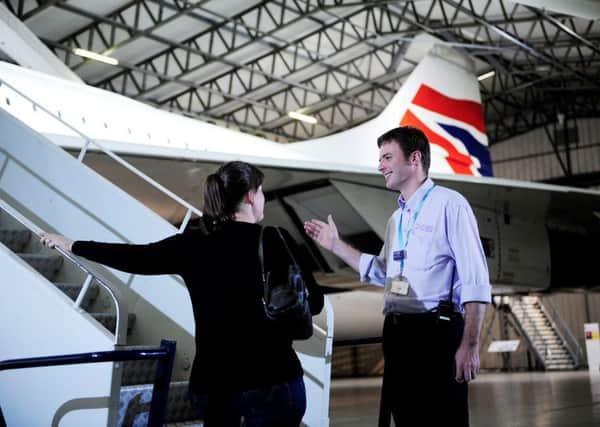National Museum of Flight is reaching for the sky


THE National Museum of Flight at East Fortune Airfield in East Lothian is home to an internationally significant collection of civil and military aircraft in the care of National Museums Scotland.
These collections date to 1909 when a model of the Wright Brothers’ Model A biplane was acquired. Later, in 1971, the Ministry of Defence donated a Mark XVI Spitfire to our collections and, due to lack of space, we acquired one of the Second World War hangars on former RAF East Fortune to store the aircraft.
Advertisement
Hide AdAdvertisement
Hide AdThe seeds were thus sown for the development of the National Museum of Flight and it officially opened to the public on 7 July 1975.
East Fortune airfield is of major historical significance, and much is preserved today as a scheduled monument.
It originally opened in 1915 as a Royal Naval air-station, housing huge airships and early First World War aircraft, predominantly for carrying out anti-submarine patrols and Zeppelin interception duties.
Throughout the Second World War, the airfield became a Royal Air Force station, and served as an operational training unit.
The museum today occupies just the Second World War part of the airfield. Much of the rest of the wider site, including the runways, are in private ownership.
The past ten years have seen exciting changes at the National Museum of Flight with the arrival of Scotland’s Concorde in 2004 which trebled visitor numbers to the site, putting the Museum on the map
This acted as a catalyst for extensive development including two new exhibitions, Fantastic Flight and Fortunes of War and the creation of a dedicated learning centre and a reconstructed parachute store.
We are now working on the next major development at the site, a £3.6 million project to further enhance the museum by delivering an important restoration, conservation and interpretation project that will significantly improve the condition of two of our large Second World War hangars.
Advertisement
Hide AdAdvertisement
Hide AdThe hangars were built in 1940-41, and are still more or less in their original format.
Originally intended as temporary structures, their physical condition has deteriorated over the years and now requires some attention.
With Heritage Lottery Fund (first round pass for the next stage of our development plan) and Scottish Government funding we will restore the hangars to their First World War condition, adding insulation and ground source heating to improve the internal environment for the benefit of the collections and indeed for visitor comfort.
One of the hangars will become our new military hangar, focusing on the history and technology of military aviation from the First World War onwards, aircraft ranging from our iconic Spitfire to an ex-RAF Tornado.
The other will focus on our small civil and leisure aircraft, including the de Havilland Dragon.
The Dragon established the first passenger air services in and out of the Highlands and Islands in Scotland and flew the first airmail flights in Britain.
Also featured will be the classic “Faithful Annie” Avro Anson, which was originally built as a passenger aeroplane and also used in many roles in the armed forces and the Britten-Norman Islander, one of the most versatile aircraft ever built and used in a multitude of different roles, including commercial passenger transport, air ambulance and fisheries protection.
Improvements to the buildings will allow us to utilise much more modern and dynamic display techniques to interpret our aircraft.
Advertisement
Hide AdAdvertisement
Hide AdThese will include touchscreen displays where visitors will not only learn about the design and technology behind the aircraft but will also be able to hear stories from the people who designed them, built them, maintained them and even flew them.
Large video projections and soundscapes will provide a much more immersive experience, but we will allow for quiet times too.
This will allow visitors to enjoy reflective time exploring the collections.
The project presents an exciting opportunity to display much more material, including photographs and paper archives, thus providing a richer experience for all our future visitors.
We will offer an extensive series of public programmes as part of the project and would like to hear from anyone who has any material, be it a photograph, a note book, or even a memory of East Fortune Airfield when it was operational, or indeed was used for storage during the Cold War.
The planned transformation of the hangars into two vibrant new display spaces, worthy of our internationally significant collections will ensure that the National Museum of Flight remains one of the most important aviation museums in Europe.
• Steve Mclean is general manager at the National Museum of Flight www.nms.ac.uk
SEE ALSO